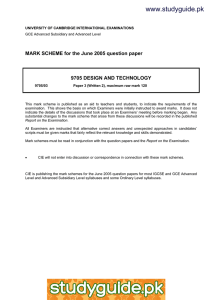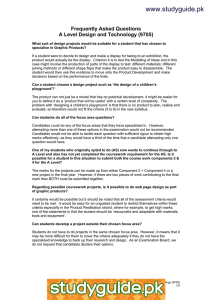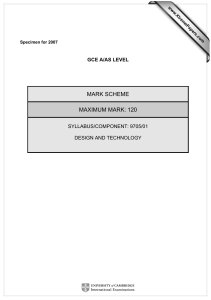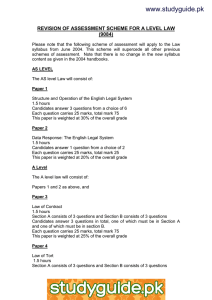www.xtremepapers.net www.studyguide.pk MARK SCHEME MAXIMUM MARK: 120
advertisement
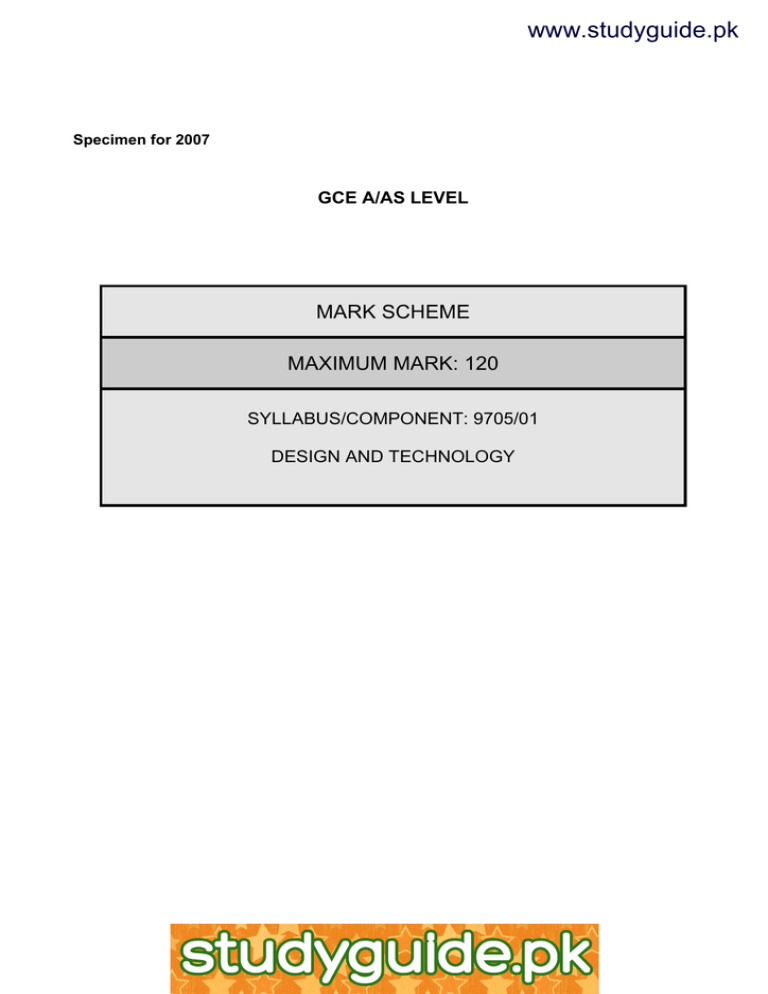
www.studyguide.pk Specimen for 2007 GCE A/AS LEVEL MARK SCHEME MAXIMUM MARK: 120 SYLLABUS/COMPONENT: 9705/01 DESIGN AND TECHNOLOGY www.xtremepapers.net www.studyguide.pk Page 2 Mark Scheme A/AS LEVEL – 2007 Syllabus 9705 Paper 1 Guidance on Examination Technique The questions on the examination paper require candidates to respond in a variety of different ways. For example, using one word answers, short sentences, detailed explanations, annotated sketches and more formal drawings. It is important that whichever method is used candidates try to make their answers as clear as possible and relate the length and depth of their responses to the number of marks available. Candidates must make sure that they do not spend too much time on questions which carry a low mark. Candidates must avoid producing superficial responses to questions which carry a high mark. Candidates must make sure that their thinking is made totally clear to the Examiner and nothing is left open to interpretation. Candidates should read through each question carefully before they start their answer. They must make sure they are clear what the question is asking them to do. Answers must be focused in a way that responds fully to the question being asked. When answering questions it is important that candidates make sure that they apply their subject specific knowledge and understanding rather than general knowledge. Candidates frequently lose marks on examination papers because they misread or misunderstand important words in questions. A list of the most commonly used words is given below. GIVE/STATE/NAME This generally requires the specific name of an object, process or material to be given. Normally, a one- or two-word answer is sufficient; at the very most, a short sentence. Marks will rarely be given for general terms such as ‘wood’, ‘glue’ or ‘printing’. LIST This requires information to be arranged in an appropriate order. It can require single words (e.g. ‘List the equipment you would use to make...’) or phrases (e.g. ‘List the stages in making ...’). Where the order is important, questions will generally read: ‘List in order ...’ or ‘List in order of importance ...’. DESCRIBE This requires you to give an idea of what an object looks like and how it functions or what is involved in a process. It normally involves a statement or account of something consisting of one or two sentences that make reference to aspects such as form, function and properties of the object or process (e.g. ‘Describe how a company logo could be incorporated into the graphics on an item of packaging’ or ‘Describe how market research can be used to ...’). When a question requires a candidate to use ‘Sketches and notes to describe ....’ the use of continuous text should be avoided. EXPLAIN This normally requires a clear, detailed account of something, including reasons, justifications and examples (e.g. ‘Explain how the increased use of CAD/CAM in industry has affected employment in this country.’) © University of Cambridge International Examinations 2005 www.xtremepapers.net www.studyguide.pk Page 3 Mark Scheme A/AS LEVEL – 2007 Syllabus 9705 Paper 1 COMPARE A comparison must involve analysis. It is a recording of the similarities and/or differences between two or more similar products. Making judgements and drawing conclusion often forms part of this process. ANALYSIS This normally requires you to study designs and involves asking, and answering, questions about them, such as ‘What is it?’ ‘What is its function?’ ‘Does it do its job well?’ ‘Is it easy to use?’ ‘Does it look attractive?’ ‘Is it value for money?’ ‘In what ways could it be improved?’ A close examination of this kind often reveals weaknesses in a design. DISCUSS This requires the candidate to examine critically the issues raised by the question and to explain and interpret these issues as appropriate. Evidence should be introduced wherever possible to support the conclusions of arguments that they make. ADVANTAGES AND DISADVANTAGES Questions which include these words have marks allocated to each, so candidates must give both to gain access to full marks. For example, ‘An advantage of using lithography for the printing of packaging is that it is the most economical process for general printing, and a disadvantage is that the plate life is limited to 150,000 copies. CALCULATE This word simply means ‘Work out’. Marks are usually awarded for both process and the answer. Candidates who write only an answer will not gain the process mark even if the answer is correct. USE SKETCHES AND NOTES (ANNOTATED SKETCHES) This indicates that candidates should answer the question using both sketches and notes to support or clarify particular points in the answer. Marks for such questions are allocated to both methods of communication. Candidates who write continuous prose, or just produce sketches, will not have access to all of the marks. The clarity and quality of communication must be of a high standard to gain good marks. DEVELOP This means to improve on a basic idea. Candidates are normally expected to show a workable or worthwhile solution. Details are generally required about materials, construction and other relevant technical aspects. EVALUATE This involves making informed judgements about products and processes against clear criteria. These criteria may be given in the question or the candidate may be required to formulate them. © University of Cambridge International Examinations 2005 www.xtremepapers.net www.studyguide.pk Page 4 Mark Scheme A/AS LEVEL – 2007 Syllabus 9705 Paper 1 Section A Questions in this section will test a candidate’s knowledge and understanding of the Core specification. While the main focus of these questions will be materials, materials processing and health and safety related to the manufacture of products other aspects of the Core specification may also be tested. When marking questions, Examiners award one mark for each appropriate piece of information or detail that a candidate gives in their response. Each key word, phrase or part of a sketch or drawing is usually ticked to show where the mark has been awarded. 1 (a) Two marks are available, one for naming a suitable wood and one for giving an appropriate reason for the choice of the wood. (b) In (b) six marks are available for each of the three sections of this part of the question. The Examiner would, therefore, be looking for six key pieces of information/details. This information/details must, as the question states, relate to the tools, equipment and processes involved and the safety precautions that have to be undertaken. The candidate should use a series of annotated sketches to describe clearly, stage by stage, how the required activity would be carried out. It is not sufficient to just list and/draw the tools, etc. The candidate must describe how they would be used. The use of continuous prose should be avoided. 1 (a) Suitable wood named e.g. plywood, MDF Suitable reason given e.g. available, in large sizes (1) (1) [2] (b) (i) Marking out described Details of tools, equipment and safety precautions (if appropriate) (0-3) (0-3) [6] (ii) Cutting and finishing described Details of tools, equipment and safety precautions (if appropriate) (0-3) (0-3) [6] (iii) Applying suitable surface finish explained Details of tools, equipment and safety precautions (if appropriate) (0-3) (0-3) [6] [Total 20] The marking of Question 2 would follow the same format as that of Question 1. 2 (a) Suitable sheet material named e.g. acrylic, polystyrene, stainless steel Suitable reason given e.g. not affect by water, is easy to clean (1) (1) [2] (b) (i) Marking out described Details of tools, equipment and safety precautions (if appropriate) (0-3) (0-3) [6] (ii) Cutting and finishing described Details of tools equipment and safety precautions (if appropriate) (0-3) (0-3) [6] (iii) Bending explained Details of tools equipment and safety precautions (if appropriate) (0-3) (0-3) [6] [Total 20] © University of Cambridge International Examinations 2005 www.xtremepapers.net www.studyguide.pk Page 5 3 Mark Scheme A/AS LEVEL – 2007 Syllabus 9705 Paper 1 (a) The marking of part (a) would follow the same format as that used for part (a) in Questions 1 and 2. (b) There are six marks available for this part of the question. If both a slot and tab were shown (see below) but the tab would not hold securely in the slot up to three marks could be gained. 1 mark for the tab, 1 mark for the slot and 1 mark for the notes explaining the fixing. If an effective slot and tab fixing was shown (see below), up to a further three marks could be gained. 1 mark for the ends on the tab, 1 mark for the slot being an appropriate length for the tab to lock in and a 1 mark for additional notes that explain how the fixing locks in place. Once again, the Examiner would be looking for six key pieces of information/details. (c) There are six pieces of information/details that the Examiner would be looking for in answers to this part of the question. (See below.) (d) This part of the question would be marked in the same way as similar parts of Question 1 and 2. 3 (a) Suitable card named e.g. white board, cardboard Suitable reason given e.g. good surface to print on (1) (1) [2] (b) Both slot and tab shown but tab would not hold securely in the slot (0-3) Effective slot and tab fixing shows which would join corners securely together (4-6) [6] (c) Appropriate scale used Base shown Four sides shown Top shown Fold in flap and cut/folded section shown Corner fixings shown (1) (1) (1) (1) (1) (1) [6] (d) Marking and cutting out explained Details of tools equipment and safety precautions (if appropriate) (0-3) (0-3) [6] [Total 20] © University of Cambridge International Examinations 2005 www.xtremepapers.net www.studyguide.pk Mark Scheme A/AS LEVEL – 2007 Page 6 Syllabus 9705 Paper 1 SECTION B This section consists of product analysis questions. While the main focus of these questions will be to assess a candidate’s ability to analyse existing products in terms of function, aesthetics, ergonomics, types and properties of materials, production techniques and safety, other aspects of the Core specification may also be tested as part of this process. For example, as part of a question, candidates may be asked to make an improvement to an existing design based on the product analysis that they have undertaken or problems that have been identified in the question. Where more than one reason or explanation is asked for, candidates should make sure that their answers are distinctly different and do not say the same thing twice using slightly different words. There is no one correct answer to questions in this section of the examination paper. 4 (a) The two marks available for this part of the question indicate that the explanation needs to include two key features. For example ‘The curved shape is one that can be easily formed from plastic sheet (1 mark) and will allow the rain to run off the roof.’ (1 mark) (b) This part of the question asks for two problems to be described. Therefore, each problem has two marks allocated to it. An example of an appropriate problem would be ‘Some plywood delaminates when it gets wet (1 mark) because the water dissolves the glue.’ (1 mark) (c) An explanation of an appropriate way in which each problem could be overcome can gain up to three marks. An example of a suitable solution would be ‘Exterior grade plywood could be used (1 mark). This would overcome the problem because the glue used is waterproof (1 mark) this makes the bond stronger than the wood itself. (1 mark) (d) This part of the question is structured in such a way that it is very clear to the candidate how the eight marks will be awarded. Candidates must, however, avoid just listing information as the marks will be awarded for the quality and depth of analysis and discussion that takes place. The other questions in this section will be marked using the same format. 4 (a) Appropriate explanation (0-2) [2] (b) Problem 1 described Problem 2 described (0-2) (0-2) [4] (c) Explanation of how Problem 1 could be overcome Explanation of how Problem 2 could be overcome (0-3) (0-3) [6] (d) Situation has been analysed and relevant issues/points identified Explanation of why issues/points are considered relevant Specific example or evidence used to support answer (3 x 1) (3 x 1) (0-2) [8] [Total 20] 5 (a) Appropriate explanation e.g. Related to bag folding flat for storage and expanding when full of shopping. (b) Problem 1 described Problem 2 described e.g. Problems related to bags and handles breaking. Some types of handle are uncomfortable to hold when the bag is full of heavy shopping. © University of Cambridge International Examinations 2005 www.xtremepapers.net (0-2) [2] (0-2) (0-2) [4] www.studyguide.pk Page 7 Mark Scheme A/AS LEVEL – 2007 Syllabus 9705 (c) Explanation of how Problem 1 could be overcome Explanation of how Problem 2 could be overcome e.g. Solutions related to ways in which the bags could be reinforced. Use of alternative materials. Improved handle design. (0-3) (0-3) (d) Situation has been analysed and relevant issues/points identified Explanation of why issues/points are considered relevant Specific example or evidence used to support answer (3 x 1) (3 x 1) (0-2) Paper 1 [6] [8] [Total 20] 6 (a) Appropriate explanation (0-2) e.g. Related to lantern being hard to make in one piece. Heavy to carry if one piece. Need to get inside for maintenance. [2] (b) Problem 1 described Problem 2 described e.g. Problems related to ferrous metals corroding when they get wet. [4] © University of Cambridge International Examinations 2005 www.xtremepapers.net (0-2) (0-2) www.studyguide.pk Page 8 Mark Scheme A/AS LEVEL – 2007 Syllabus 9705 (c) Explanation of how Problem 1 could be overcome Explanation of how Problem 2 could be overcome e.g. Various surface treatments that could be applied. Possible use of alternative materials. (0-3) (0-3) (d) Situation has been analysed and relevant issues/points identified Explanation of why issues/points are considered relevant Specific example or evidence used to support answer (3 x 1) (3 x 1) (0-2) Paper 1 [6] [8] [Total 20] Section C This section contains structured design questions based on the Core specification. Candidates will be presented with an outline design proposal and be asked to develop certain features of the design so that the product would be fully functional. Candidates will also have to produce a rendered pictorial drawing of their completed design proposal. 7 (a) (i) One pre-conceived idea presented OR The development and selection of a range of ideas into a single design proposal which would appear to work but lacks some technical details OR The development and selection of a range of ideas into a single design proposal that includes sufficient technical details to show that the proposed solution would clearly work (0-3) (4-7) (8-10) Clarity and quality of notes and sketches (0-3) Evaluation (reason for selection) (0-3) (ii) One pre-conceived idea presented OR The development and selection of a range of ideas into a single design proposal which would appear to work but lacks some technical details OR The development and selection of a range of ideas into a single design proposal that includes sufficient technical details to show that the proposed solution would clearly work (0-3) (4-7) (8-10) Clarity and quality of notes and sketches (0-3) Evaluation (reason for selection) (0-3) (iii) One pre-conceived idea presented OR The development and selection of a range of ideas into a single design proposal which would appear to work but lacks some technical details OR The development and selection of a range of ideas into a single design proposal that includes sufficient technical details to show that the proposed solution would clearly work © University of Cambridge International Examinations 2005 www.xtremepapers.net [16] (0-3) (4-7) (8-10) [16] www.studyguide.pk Page 9 Mark Scheme A/AS LEVEL – 2007 Syllabus 9705 Clarity and quality of notes and sketches (0-3) Evaluation (reason for selection) (0-3) (b) (i) One pre-conceived idea presented OR The development and selection of a range of ideas into a single design proposal which would appear to work but lacks some technical details OR The development and selection of a range of ideas into a single design proposal that includes sufficient technical details to show that the proposed solution would clearly work (4-7) (8-10) (0-3) Evaluation (reason for selection) (0-3) Some use has been made of colour and tone to enhance the visual impact of the drawing. OR Good use has been made of colour and tone to enhance the visual impact of the drawing OR Very good use has been made of colour, tone and material representation to enhance the visual impact of the drawing [16] (0-3) Clarity and quality of notes and sketches (c) The drawing will exhibit a reasonable standard of outcome and show some of the required design features. OR The drawing will exhibit a good standard of outcome and show most of the design features required to make the drink carrier function as intended. OR The drawing will be completed to a high standard of outcome and fully show the design features required to make the drink carrier function as intended. Paper 1 [16] (0-3) (4-7) (8-10) (0-2) (3-4) (5-6) [16] Total 80 8 (a) (i) One pre-conceived idea presented OR The development and selection of a range of ideas into a single design proposal which would appear to work but lacks some technical details OR The development and selection of a range of ideas into a single design proposal that includes sufficient technical details to show that the proposed solution would clearly work (0-3) (4-7) (8-10) Clarity and quality of notes and sketches (0-3) Evaluation (reason for selection) (0-3) (ii) One pre-conceived idea presented OR © University of Cambridge International Examinations 2005 www.xtremepapers.net (0-3) [16] www.studyguide.pk Page 10 Mark Scheme A/AS LEVEL – 2007 The development and selection of a range of ideas into a single design proposal which would appear to work but lacks some technical details OR The development and selection of a range of ideas into a single design proposal that includes sufficient technical details to show that the proposed solution would clearly work Syllabus 9705 (4-7) (8-10) Clarity and quality of notes and sketches (0-3) Evaluation (reason for selection) (0-3) (iii) One pre-conceived idea presented OR The development and selection of a range of ideas into a single design proposal which would appear to work but lacks some technical details OR The development and selection of a range of ideas into a single design proposal that includes sufficient technical details to show that the proposed solution would clearly work (4-7) (8-10) (0-3) Evaluation (reason for selection) (0-3) (c) The drawing will exhibit a reasonable standard of outcome and show some of the required design features. OR The drawing will exhibit a good standard of outcome and show most of the design features required to make the drink carrier function as intended. OR The drawing will be completed to a high standard of outcome and fully show the design features required to make the drink carrier function as intended. Some use has been made of colour and tone to enhance the visual impact of the drawing. OR Good use has been made of colour and tone to enhance the visual impact of the drawing OR Very good use has been made of colour, tone and material representation to enhance the visual impact of the drawing [16] (0-3) Clarity and quality of notes and sketches (b) Appropriate size/proportion scale used for the net Net showing: sides, ends and vertical partition, ‘crash base’ Glue tabs and fold lines Paper 1 [16] (0-4) (0-4) (0-4) (0-4) [16] (0-3) (4-7) (8-10) (0-2) (3-4) (5-6) [16] Total 80 9 (a) (i) One pre-conceived idea presented © University of Cambridge International Examinations 2005 www.xtremepapers.net (0-3) www.studyguide.pk Page 11 Mark Scheme A/AS LEVEL – 2007 OR The development and selection of a range of ideas into a single design proposal which would appear to work but lacks some technical details OR The development and selection of a range of ideas into a single design proposal that includes sufficient technical details to show that the proposed solution would clearly work Syllabus 9705 (4-7) (8-10) Clarity and quality of notes and sketches (0-3) Evaluation (reason for selection) (0-3) (ii) One pre-conceived idea presented OR The development and selection of a range of ideas into a single design proposal which would appear to work but lacks some technical details OR The development and selection of a range of ideas into a single design proposal that includes sufficient technical details to show that the proposed solution would clearly work (4-7) (8-10) (0-3) Evaluation (reason for selection) (0-3) (4-7) (8-10) (0-3) Evaluation (reason for selection) (0-3) (4-7) (8-10) (0-3) Evaluation (reason for selection) (0-3) www.xtremepapers.net [16] (0-3) Clarity and quality of notes and sketches © University of Cambridge International Examinations 2005 [16] (0-3) Clarity and quality of notes and sketches (b) One pre-conceived idea presented OR The development and selection of a range of ideas into a single design proposal which would appear to work but lacks some technical details OR The development and selection of a range of ideas into a single design proposal that includes sufficient technical details to show that the proposed solution would clearly work [16] (0-3) Clarity and quality of notes and sketches (iii) One pre-conceived idea presented OR The development and selection of a range of ideas into a single design proposal which would appear to work but lacks some technical details OR The development and selection of a range of ideas into a single design proposal that includes sufficient technical details to show that the proposed solution would clearly work Paper 1 [16] www.studyguide.pk Page 12 Mark Scheme A/AS LEVEL – 2007 (c) The drawing will exhibit a reasonable standard of outcome and show some of required design features. OR The drawing will exhibit a good standard of outcome and show the design features required to make the wind powered toy function as intended. OR The drawing will be completed to a high standard of outcome and fully show the design features required to make the wind powered toy function as intended. Some use has been made of colour and tone to enhance the visual impact of the drawing. OR Good use has been made of colour and tone to enhance the visual impact of the drawing. OR Very good use has been made of colour, tone and material representation to enhance the visual impact of the drawing. Syllabus 9705 Paper 1 (0-3) (4-7) (8-10) (0-2) (3-4) (5-6) [16] Total 80 © University of Cambridge International Examinations 2005 www.xtremepapers.net


